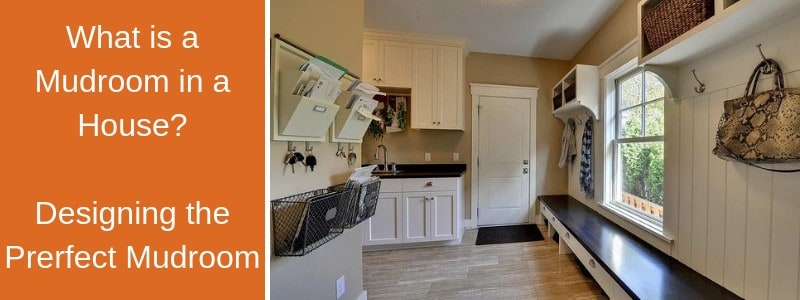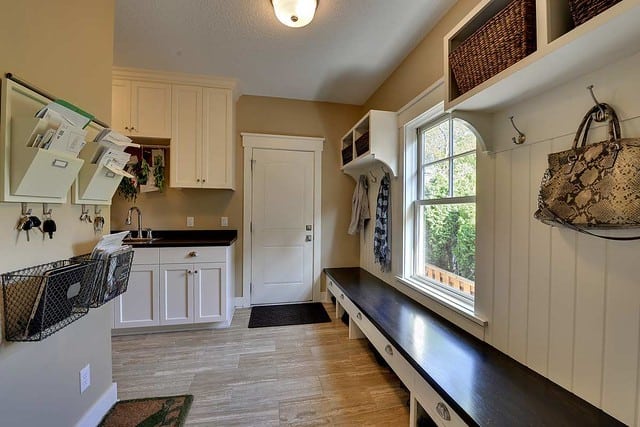There are only a few months left into summer, but the havoc that water has created is pretty messy. Soon, we will enter fall and then finally winter season. You know what this means… umbrellas and vinyl boots now, and coats, gloves, scarves, and rubber boots later.

Each season brings a different wardrobe with it, and we like to prepare in advance for the weather.
Remember the mess we mentioned above? Well, boot tracks and dripping rain water are exactly that for your entrance carpet.
A welcome mat doesn’t really do the trick of protecting your Persian rug from this mess.
Here’s an idea — why not design a mudroom in your home?
What Is a Mudroom?
Think of a mudroom as the second entrance to your home. Mudrooms offer different perks, but they all have the same purpose: to provide an open storage space and for serving as a pre-entrance area for the house.

Some families use it to clean their shoes and store items such as a briefcase and hang a coat, while others use it for collecting mail in one place and storing sports equipment and laundry.
Designing a mudroom is pretty simple, but in order to make it functional in every way, you need have the following seven elements in it:
Design Element #1: Floor
Let’s start with the basics first: the floor. Before choosing the floor, you need to keep a few things in mind such as the slip factor, maintenance, and mold. There are two options: ceramic tile and natural stone.
-
Ceramic Tile
This floor material is considered as one of the best for mudrooms. It’s non-porous and durable, which protects it from water and mud.
Moreover, there are plenty of designs that mimic hardwood and stone. It’s not that expensive and will fit right into your budget.
The only drawback of ceramic tile is that it can become quite slippery when wet. However, you can fix this problem by covering it with a coat of slip resistant seal.
-
Natural Stone
The beauty of natural stone can never be copied. This floor material offers the same benefits as ceramic tile but it can be quite expensive depending on the type of stone you have chosen. Its low maintenance and you can easily clean it with a mop.
Design Element #2: Hooks and Racks
Umbrellas, scarves, coats, shoes and hats, they all need a place for hanging out. Granted, you don’t need a mudroom for that but wouldn’t it be easy to grab everything from one place rather than rooting around for them in your cupboard?
Start small by adding a rack for shoes and a hook or two for the coats. Then analyze the space and find out where the hooks and shelves will be more functional.
Design Element #3: Bench
When coming home exhausted from work, the first thing you like to do is take off your shoes and rest for a minute. Install a comfy bench, preferably one with a seat that flips up so that you have concealed storage. If you are feeling fancy, get a boot tray so that you don’t have to bend down when removing shoes.
Design Element #4: Laundry Machine
If your laundry machine is in the basement then move it to the mudroom. You can throw the dirty laundry directly into the washing machine without dirtying the rest of the house. Plus, moving the machine here makes it more accessible.
Design Element #5: Sink
For quick washing, a sink will come quite in handy. You can use it for gardening, hosing off pets, cleaning up crafts and paint supplies, etc.
Don’t forget to create an indoor corner for your pet, if you have one. A soft bed, a couple of bowls and color leashes hanging from the hooks will add a nice touch to the mudroom.
Design Element #6: Cubbies
When talking about aesthetics, cubbies are the best furniture items. You can design them according to individual family member preference. This way, everyone will have their own personal storage space.
Design Element #7: Closet
Yes, a mudroom in itself is a giant closet but getting separate standing closet will allow you to store out-of-season item such as ski boards, surfing boards, skating shoes, etc. Then there are the cleaning supplies, sports equipment and miscellaneous items.
Final Words
So now when someone asks, “What is a mudroom?” you can take them into your walk-in storage closet. Since this room is purely for storage, most people don’t add luxurious items.
However, you can throw in some color by hanging a few abstract wall paintings and placing throw cushions on the bench.
This will add both aesthetics and functionality to the room. A perfectly designed mudroom will make your life pretty easy so do think about turning that spare room at the back of the house into a storage space.
Related Posts
- How to Protect Sliding Glass Doors from Burglars: Essential Security Tips
- How Long Do Sliding Glass Doors Last? Durability and Lifespan Explained
- Here Are Some Pros and Cons of Textured Walls in Homes
- Why Do Sliding Doors Get Stuck? Common Causes and Solutions
- Comparison of Knockdown Drywall Texture vs Orange Peel
- Some FAQ (Frequently Asked Questions) About Wall Paneling for Homes
Leave a Reply